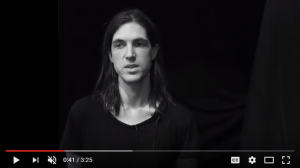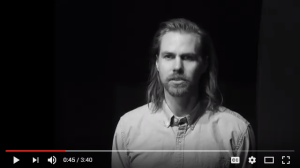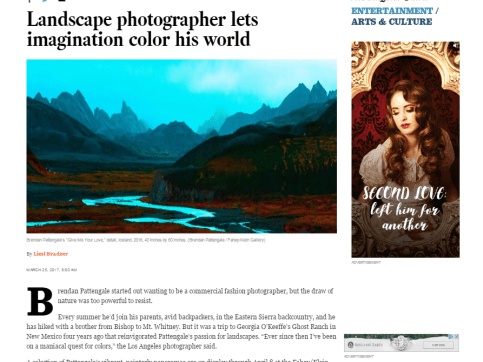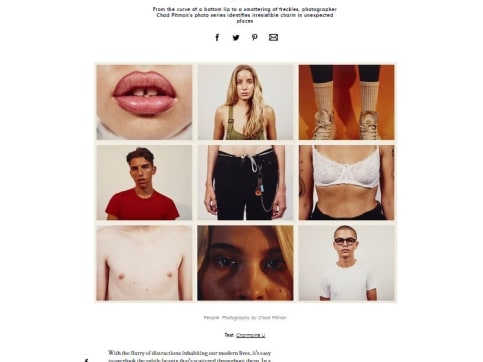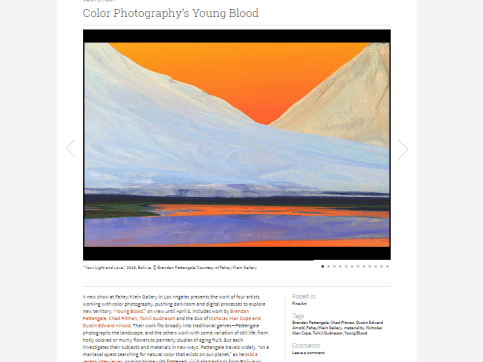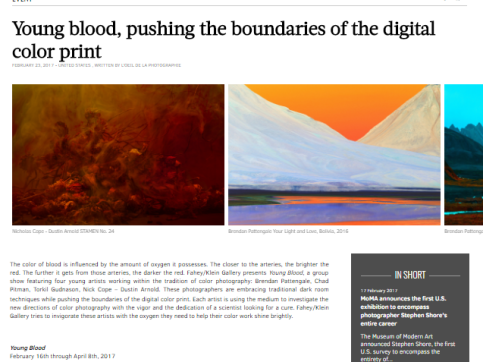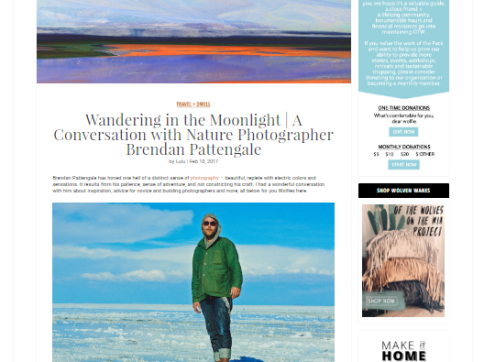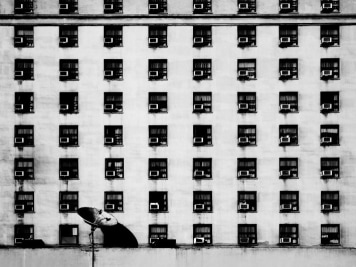
The color of blood is influenced by the amount of oxygen it possesses. The closer to the arteries, the brighter the red. The further it gets from those arteries, the darker the red. Fahey/Klein Gallery is pleased to present “Young Blood” a group show featuring four young artists working within the tradition of color photography. These photographers are embracing traditional dark room techniques while pushing the boundaries of the digital color print. Each artist is using the medium to investigate the new directions of color photography with the vigor and the dedication of a scientist looking for a cure. Fahey/Klein Gallery is looking forward to the opportunity to invigorate these artists with the oxygen they need to help their color work shine brightly.
Brendan Pattengale (b. 1984) is an American photographer. Taking up the tradition of landscape photography to situate his musings, Pattengale probes photographic methods as well as the truth in color perception. His photographs are strikingly abstract, psychedelic in the way that they vividly depict valleys and vistas, yet they maintain a certain realism in the subject matter. Utilizing an unorthodox set of tools to capture his chosen terrain—Pattengale travels to the far reaches of the world to find new sceneries—he calls into question the role of the camera as vicarious viewer relative to an image making process that involves other mechanical and non-mechanical agents. As was said by Goethe in his Theory of Colors, colors belong to the eye; Pattengale conveys this in his images, which are entirely true in their retelling of light and, therefore, vision, while they are also altered in their process prior to the instant of the photograph.
“My camera, here, is merely the form of documentation while the fruit starts to become the negative, holding time and light in its skin for us to see. Youth only lasts so long. Life sets in. We are shaped from the beginning. And while lemons are pretty to look at, they are also bitter to taste.”, Chad Pitman.
In Chad Pitman’s new body of work COLOR & FIGURES the still life genre is reconsidered through the serial capture of one of the medium’s most popular subjects: fruit. Unlike familiar still life, however, Pitman’s images are subject to time. Over the course of a year, the artist regularly photographed the same pieces of fruit as they decomposed against backgrounds of a complimentary hue. While clearly photographs, Pitman’s works are very much painterly in their composition and suggestive of a highly considered process in the overall congruence of the series. The deconstruction of the signifier (in this case the fruit) into something new entirely brings to light a new language. When seen together as a complete story, these images communicate the delicacy of a moment while also reconsidering standards of beauty. In Pitman’s photographs decomposition becomes appealing as it is seen mostly for its resulting color and form; the process documented is not a transition into an end but a transition into permanence as art.
Chad Pitman (b. 1981) attended the New England School of Photography in Boston. He has shown at Cash Machine in Los Angeles, CA and Slow Culture in Los Angeles, CA. He has published two art books entitled Valley Pines and Waves Asphalt Light.
Both with varying backgrounds in photography and design Nicholas Cope and Dustin Arnold met through a commercial project in 2007 and began their first collaboration in October of 2009. Each working beyond their respective discipline they combine the mediums of painting, chemistry, sculpture, fashion and installation as a part of their image-making process. Their imaginative collaborations challenge the traditional genres of photography. Nothing is safe from their collaborations, fashion, still life and architecture are all represented in their investigations and discoveries.
In Torkil Gudnason’s study of flowers, Electric Blossom and Hothouse Color, Gudnason once more coaxes fresh, unexpected dimensions from a classic subject through the use of vibrant color and dynamic compositions. Flowers have been willing models for artists throughout time - the "original symbol," as Gudnason says. Canonical flower photographs tend to portray flowers as gorgeous exemplars of purity, distilled color and form. Gudnason takes the photography of flowers one feverish step further - seeming to jump from behind of the camera and into the flowers - capturing their floriferous essence from the inside. With his flowers, as is true in all of his work, there's a delirious and intoxicating undercurrent beneath the pure, angular surfaces, a magical something that transforms his images into experiences.




















